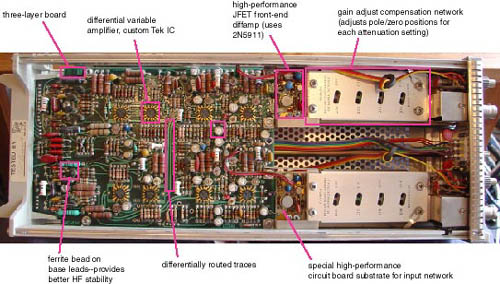This past month’s name that ware was a breeze for the contestants! I think in a little under a day people had written some fairly detailed, well-thought out responses. I’m impressed!
Chosing a winner this month is difficult; Nate had the earlier correct response, but DavidR had a more detailed response with a bit more of his thought process detailed. Given the spirit of the contest–not just winning, but also trying to help others learn about reverse engineering through example–I’ll declare DavidR the winner, but I also think Nate deserves a prize for coming up with such an impressively quick response. Congratulations to you both!
The solution, of course, is the Tek 7A26 dual trace amplifier, donated to me by Mike Fitzmorris, a brilliant analog IC engineer. Mike spent a little while talking me through some of the more interesting features of the 7A26 module; a few of the easier ones to call out in a single plan-view picture are shown below. I’ve always held a deep respect for the designers of test equipment. For all the crazy 40 Gbps optical links out there, and the 20 GHz radios, and the crazy sub-picosecond jitter microprocessor clock distribution networks, there is an instrument that people are using to measure that stuff. Sure, the instrument costs as much as an exotic sports car, but it’s just impressive that someone went and built something that can measure, with useful resolution, something as cutting edge as a 40 Gbps signal. Back in the day, the 7A26 was an impressive piece of work, and one can see the level of detailed engineering, tweaking and tuning that went into this module.
